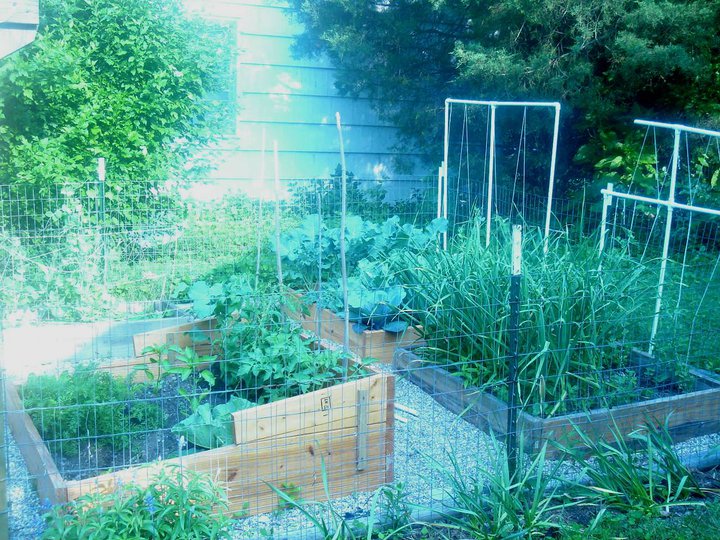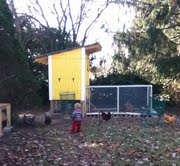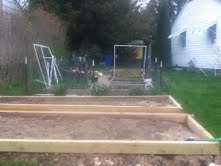April 27, 2013
by Jennifer Naylor
A few months ago, the lovely Georgia Schaich asked me to write a blog post for GANA. Today, as I was digging away in our front garden and perennial beds, and my hens were clucking around the backyard, I decided I better get to it! For those of you I have not met, my name is Jen Naylor and I live on E. 4th Street with my husband Shawn, our two sons, two dogs and a flock of backyard chickens.
We moved to Green Acres five years ago, and after a period of years during which we had no real roots or green space, we were eager to starting planning, digging and growing. We immediately dug the first few square garden boxes, and plenty of landscaping beds as well. The front of our house faces south, and the backyard is lovely and large with two huge Maple trees…so we decided we would food garden in the front yard.
In the first three years, we landscaped three sides of the house, developed about 100 square feet of fenced in vegetable beds and had planted numerous blueberry, raspberry and blackberry plants.
We had also brought two babies into our family, and were quite busy here at home.
My husband Shawn had been contemplating backyard chickens for some time. Though I was tiring of buying eight or more dozen eggs a month to keep everyone here fed, I felt that hens would be simply too much work to add onto what already seemed like an endless chore list. But last spring, he took the plunge and ordered the days old baby chicks to be delivered, then spent the next months tirelessly working on the construction and security of a lively yellow chicken coop for our backyard.
The children really enjoyed them and although they were not laying much for quite a few months, they did start to make quick work of the endless piles of yard waste we had piled in our backyard. Then they started laying, and after a year of keeping this sweet little flock, I am sold on the value of adding hens to a household trying to work towards sustainability, food independence, and beautification. Here are a few tips, cautions and highlights from our brief experience thus far keeping backyard hens.
-
The bulk of the labor involved really is building a secure and stable coop. Pre-fabricated options abound, as do purchased plans and ideas for repurposing old items into coops. The strategy I suggest to friends interested is to build the coop in the fall, as to avoid having chicks growing faster than you can build in the spring.
-
Hens will eat almost all kitchen waste, and gladly. There are myriad techniques to harnessing the power of their manure as fertilizer; we are attempting to use a deep litter with our hens, which means cleaning out the coop only annually. They are not particularly dirty or stinky. They also turn all and any composting materials that they can find, and do so relentlessly. We have seen piles that we thought would never break down turn into the most lovely, fertile soil more quickly than we ever thought possible.
-
When you are leaving town, you need someone to come by daily to be sure they have clean water, feed and to collect the eggs.

-
We are finding that our dogs co-exist with our hens surprisingly well. However, we did spend the first full year managing them entirely separate, and would have continued to do so if they had not accidentally been free ranging the back yard together and forced us to see that no one cared much about the other back there.
-
By one year of age, we are getting about an egg a day per bird. But over the winter months you see a sharp decline, from around the solstice to mid-February. One can put lights and lamps into a coop to force laying to continue, but they will in the end stop laying sooner in life because of that lack of rest.
-
Fresh eggs are delicious and a worthy reward for what little time and energy the birds actually require of you.
We are often out and about in our front yard, as there is always work to be done. We love living in Green Acres, and are happy to answer any questions or show you what we have done to start our little urban homestead. It continues to grow, as Shawn is working on the construction of a hoop house as an addition to the existing vegetable beds…at times it is pretty wild, but there is often something to pick and eat, and we are always learning and improving our strategies. Happy Spring, neighbors!






Pingback: May Meeting: longer than usual, spirited, at times contentious, but fun! | Green Acres Neighborhood Association